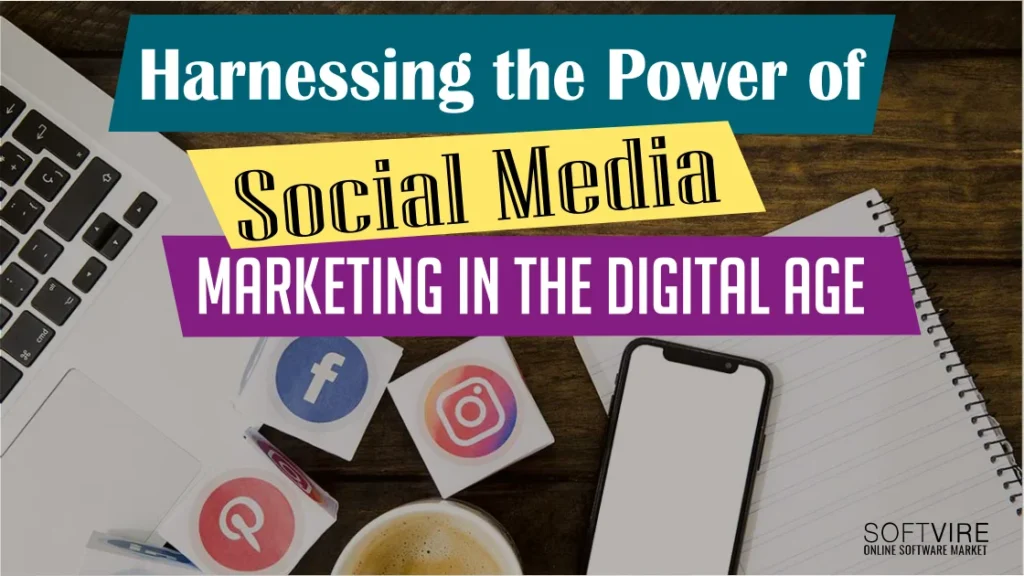Social media has evolved in today’s digital world, integral to our lives. With billions of active users across various platforms, social media offers immense opportunities for businesses to engage with their target audience and increase brand awareness.
In this blog, we will explore the power of social media marketing and discuss strategies for businesses to harness its potential in the digital age effectively.
The Impact of Social Media Marketing
Social media marketing has revolutionized how businesses reach and engage with customers. It has transformed traditional marketing practices by providing direct communication, enabling personalized interactions, and fostering brand loyalty. Social media marketing has an impact in several significant areas:
- Brand Awareness and Visibility: Businesses can exhibit their products and services to a large audience through social media networks with a worldwide reach. Businesses may significantly increase brand exposure and visibility through social media, reaching clients who would otherwise be inaccessible through traditional marketing methods.
- Targeted Advertising and Audience Segmentation: Social media platforms offer sophisticated targeting capabilities that enable businesses to reach specific demographic groups based on their interests, behaviors, and preferences. This allows for highly effective and efficient advertising campaigns, ensuring marketing messages are delivered to the right audience at the right time.
- Engagement and Customer Relationships: Social media facilitates two-way communication between businesses and customers, enabling real-time feedback, conversations, and engagement. Businesses can build meaningful relationships and foster customer loyalty by actively interacting with their audience through comments, direct messages, and social media groups.
Strategies for Effective Social Media Marketing
To effectively harness the power of social media marketing in the digital age, businesses should consider implementing the following strategies:
- Define Clear Objectives: Before embarking on social media marketing, businesses should define clear objectives that align with their overall marketing goals. Whether the aim is to raise brand awareness, improve website traffic, generate leads, or increase revenue, having well-defined objectives provides direction and helps measure success.
- Know Your Audience: Understanding the target audience is essential for effective social media marketing. Businesses should do extensive market research to find their audience’s demographics, preferences, and behaviors. This knowledge allows for creating relevant and compelling material relevant to the intended audience and the chances of capturing their attention and driving desired actions.
- Consistent Branding and Messaging: Consistency is vital in social media marketing. Businesses should establish a strong brand identity to ensure consistent branding across all social media channels. This includes using consistent brand colors, logos, fonts, and messaging. Consistent branding helps build recognition and reinforces the brand’s values and personality.
- Quality Content Creation: High-quality content is at the core of successful social media marketing. Businesses should strive to create valuable, informative, entertaining, and shareable content. Visual content, such as images and videos, performs well on social media platforms. Additionally, businesses should tailor their content to suit each platform’s unique features and audience preferences.
- Engage and Interact: Active engagement is crucial for building strong relationships with the audience. Businesses should regularly interact with their followers by responding to comments, messages, and mentions. Engaging with the audience shows that the business values their input and builds a sense of community.
Influencer Marketing and Social Media
In recent years, influencer marketing has emerged as a powerful strategy within social media marketing. Influencers have established credibility and a large following in a specific niche or industry.
Collaborating with influencers allows businesses to tap into their engaged audience and leverage their influence to promote products or services.
When implementing influencer marketing, businesses should consider the following:
- Relevance and Authenticity: It is crucial to select influencers whose values and audience align with the brand. Partnering with influencers who have genuine connections with their followers and share authentic content can lead to more meaningful and impactful collaborations.
- Transparency and Disclosure: Ethical practices should be upheld in influencer marketing. Clear disclosure of sponsored content is essential to maintain transparency and ensure the audience understands the relationship between the influencer and the brand. This transparency builds trust and credibility for both the influencer and the business.
- Micro-Influencers and Niche Marketing: While macro-influencers with massive followings can reach a broad audience, micro-influencers with smaller but highly engaged communities can be equally effective. Micro-influencers often have a more targeted and niche audience, allowing businesses to connect with a specific segment of their target market.
Social Listening and Reputation Management
Social media platforms offer businesses unique real-time opportunities to monitor conversations, gather feedback, and track brand sentiment. Social listening refers to monitoring and analyzing social media conversations and mentions related to the brand, products, or industry.
It enables organizations to acquire insight into their customers’ opinions., preferences, and trends, helping them make informed decisions and improve their offerings.
Reputation management is closely tied to social listening. By actively monitoring social media platforms, businesses can effectively address customer concerns, respond to feedback, and manage their online reputation. Prompt and empathetic responses to both positive and negative feedback demonstrate a commitment to customer satisfaction and can turn dissatisfied customers into brand advocates.
Social Media Advertising and ROI
Social media platforms offer robust advertising capabilities that enable firms to target specific demographics and measure their advertising campaigns’ return on investment (ROI). Paid social media advertising can complement organic efforts by reaching a broader audience, driving website traffic, and generating leads.
To maximize ROI in social media advertising, businesses should consider the following:
- Audience Targeting: Social media platforms provide advanced targeting options based on demographics, interests, behaviors, and past interactions. Businesses should leverage these targeting capabilities to reach the most relevant product or service audience.
- Ad Creative and Messaging: Compelling ad creative and messaging play a significant role in capturing the attention of social media users. Businesses should create visually appealing ads that align with their brand and incorporate persuasive messaging to drive desired actions.
- Testing and Optimization: A/B testing different ad variations and optimizing campaigns based on performance metrics can assist in boosting the effectiveness of social media advertising. Continual monitoring, analyzing, and refining campaigns based on data insights can lead to better results and higher ROI.
Embracing Video Content and Live Streaming
Video content has emerged as a dominant force in social media marketing. Platforms like YouTube, Instagram, and TikTok have witnessed a significant rise in video consumption. Businesses can leverage the power of video to engage their audience, tell compelling stories, and showcase their products or services.
Here are some critical considerations for incorporating video content and live streaming into social media marketing:
- Engaging and High-Quality Content: Video content should be visually appealing, well-produced, and tailored to the target audience’s preferences. Businesses should focus on creating informative, entertaining content that provides value to viewers. Storytelling through video can help capture attention, evoke emotions, and leave a lasting impression.
- Live Streaming: Live streaming enables businesses to connect with their audience in real time and foster a sense of authenticity and immediacy. Product launches can benefit from live feeds, behind-the-scenes looks, Q&A sessions, and interactive events. It allows for direct viewer engagement through live comments and reactions, creating a sense of community and building stronger relationships.
- Optimization for Mobile Viewing: With most social media users accessing platforms on their mobile devices, businesses should ensure that their video content is optimized for mobile viewing. This includes using mobile-friendly formats and captions and creating visually impactful videos on smaller screens.
Social Media Analytics and Data-driven Insights
Social media platforms provide robust analytics tools that offer valuable insights into the performance of social media marketing efforts. By leveraging these analytics, businesses can gain a deeper understanding of their audience, track engagement metrics, and measure the effectiveness of their strategies.
Key areas to focus on when analyzing social media data include:
- Audience Insights: Social media analytics provide demographic information, engagement patterns, and audience behavior data. By analyzing this information, businesses can refine their target audience, understand their preferences, and tailor their content and messaging accordingly.
- Content Performance: Social media analytics help businesses identify the types of content that resonate the most with their audience. By monitoring engagement metrics like likes, shares, comments, and click-through rates, businesses can assess which content drives the most engagement and adjust their content strategy accordingly.
- Campaign Optimization: Social media analytics enable businesses to measure their campaigns’ ROI and identify improvement areas. By tracking conversion rates, website traffic, and other vital metrics, businesses can optimize their campaigns, allocate resources effectively, and maximize their social media marketing efforts.
Conclusion:
In the digital age, social media marketing has become an indispensable tool for businesses to connect with their audience, amplify their brand, and drive growth. By embracing video content and live streaming, leveraging social media analytics, and optimizing their strategies based on data-driven insights, businesses can effectively harness the power of social media marketing.
However, staying agile and adapting to the ever-evolving social media landscape is essential. New platforms, features, and trends will continue to emerge, presenting new opportunities for businesses to engage with their audience. By staying informed, keeping up with industry best practices, and maintaining a customer-centric approach, businesses can navigate the dynamic world of social media marketing and reap its benefits in the digital age.
Check out the different Microsoft software products today if you need trusted software that uses AI ethically and efficiently. They continue to lead in using AI for their many office tools like Office 365. Get discounted Office 365 in the USA now!



